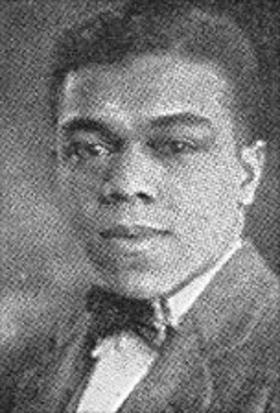William J. Knox, Jr., ca. 1925

William J. Knox, Jr. shown at the time he earned his Bachelor of Arts in Chemistry from Harvard University, ca. 1925.
William Jacob Knox, Jr. MS '29, PhD '35 of New Bedford, Massachusetts was among the handful of black scientists who worked on the Manhattan Project, which developed the atom bomb that ended World War II. After the war, he continued to break racial barriers at Eastman Kodak, where he worked on chemical agents that improved color photography.
Background
Knox’s grandfather, Elijah, was born into slavery in North Carolina, became a skilled carpenter, and purchased his freedom in 1846. Public records and oral histories hint that Elijah’s sister was Harriet Jacobs, writer of the slave narrative Incidents in the Life of a Slave Girl.
Knox was the eldest of three brothers, all of whom would attend Harvard University as undergraduates and earn PhDs.
That one family should produce almost 7% of all black Ph.D. chemists over a 25-year period is remarkable—especially a family with its roots in the slave-holding South.
Leon Gortler and Stephen J. Weininger, Chemical Heritage Magazine, Summer 2010
At Harvard, Knox’s exclusion from freshman housing sparked the ‘Harvard Dormitory Crisis’ of 1921:
[Knox] was assigned to a room in Standish B. 32, and sent a porter’s card [from New Bedford] to admit his bags and belongings. It happened that one subject, chemistry laboratory, had to be taken in Cambridge for which he appeared in person. This was the beginning of all the trouble. He was “spotted” at once, being brown in complexion...found to have been assigned to a room in the exclusive dormitories, and by an artful method was made to give it up.
Harvard alum Raymond Pace Alexander in Blacks at Harvard by W. Sollors, C. Titcomb, T.A. Underwood, and R. Kennedy (NYU Press, 1993)
At the Institute
In 1928, after three years of teaching in the South, Knox returned North to his home state and enrolled at MIT. Within a year, he earned a Master of Science in Chemical Engineering (Course X) with a thesis involving vapor-phase esterification of acids.
Knox spent the next two years teaching at Howard University in Washington, D.C. before returning to MIT for his PhD in Chemistry (Course V). He worked on the spectroscopy of the NO2/N2O4 system, completing his degree in 1935 with a dissertation entitled “The Absorption of Light by Nitrogen Tetroxide”.
Post-MIT
Discrimination, however, generally kept black scientists like Knox from academic research, conscribing them to jobs as instructors at historically black colleges in the South. Knox taught at North Carolina Agricultural and Technical College, and then served as Head of the Department of Chemistry at Talladega College in Alabama.
In 1942, he was invited by Columbia University, where a team of scientists was attempting to isolate pure U235, which can sustain the nuclear chain reaction needed for the atom bomb. Knox was eventually appointed head of the all-white Corrosion Section. In 1944, his brother Lawrence also joined the Manhattan Project; his work on anti-malarial quinine was used in field research on the effects of atomic bomb explosions.
After World War II, Knox was able to translate the expertise he acquired during wartime to civilian industry. His expertise in corrosive substances led to a personal recommendation for employment as a research associate for Eastman Kodak, headquartered in Rochester, New York. Knox yet again broke racial barriers as the second black PhD chemist hired by Kodak. He worked on developing wetting agents (surfactants) that would maximize the bonding power of film emulsions for improved manufacturing and clearer photographic images. His subsequent quarter-century career at Kodak was remarkably prolific and highly respected. Considered a surfactant expert and known as “the man to consult about coating problems,” Knox was granted a patent annually, 21 in total over a 25-year period.